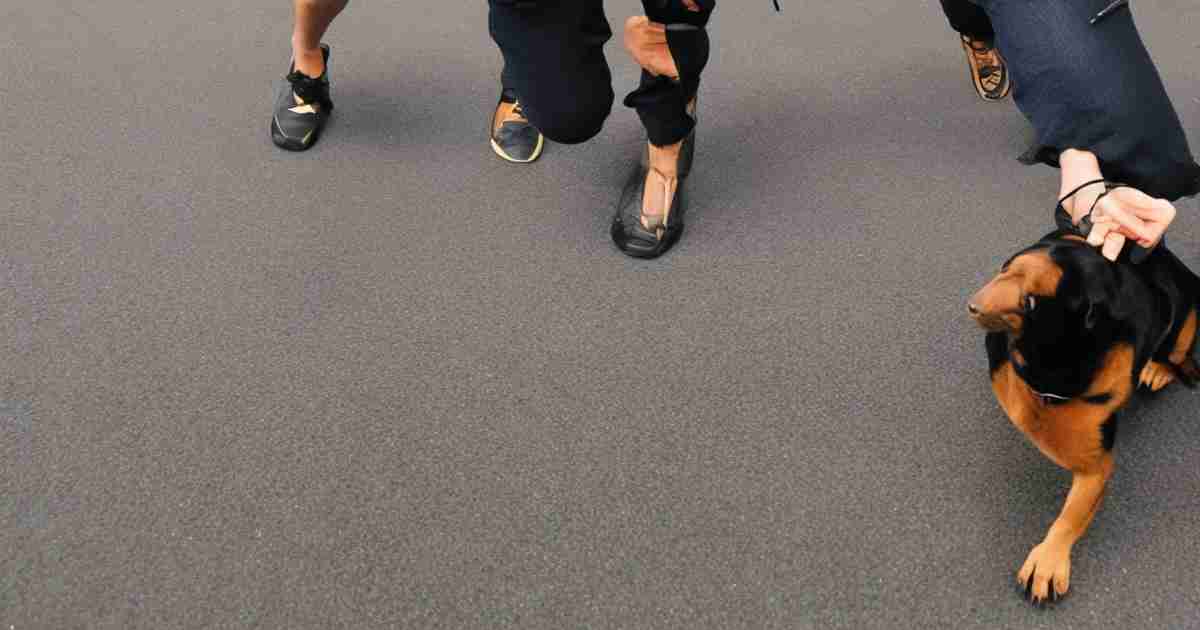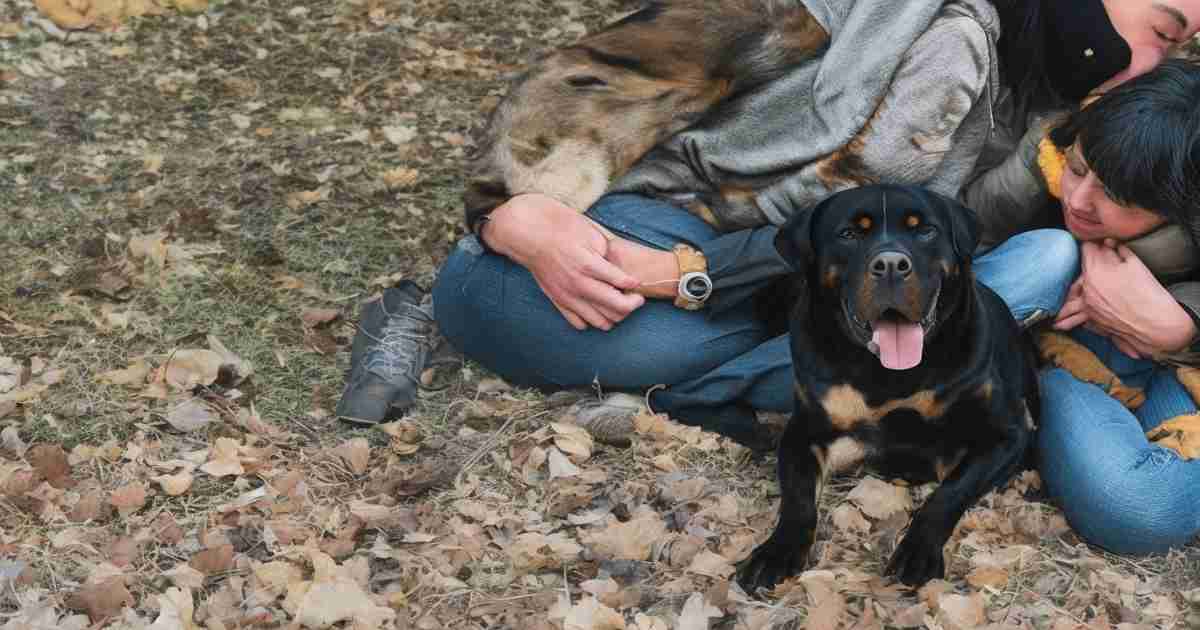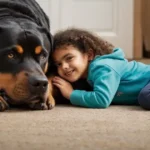Separation anxiety in Rottweiler is a critical issue every owner ought to grasp. When we leave our pups home alone, Rottweiler separation anxiety can trigger destructive behaviors, incessant barking, accidents, and intense distress.
Getting to the heart of this problem, I believe, is step one to nurturing a content, self-assured Rottweiler who stays calm whether we’re there or not.
Through experience, I’ve found separation anxiety stems from inadequate confidence and security for the dog.
Rottweiler especially thrives with purpose; these are working dogs at their core! If they feel directionless or detached from their family, anxious, stressed behaviors can escalate rapidly.
As owners, we must set our dogs up for success by satisfying their needs for activity, socialization, boundaries, and affection.
When a Rottweiler feels settled and secure in their place in the family, separation anxiety fades away.
In this article, I aim to unravel the mystery around Rottweiler’s separation anxiety. I’ll explore some common causes and actionable solutions owners can implement.
My goal is to empower Rottweiler owners to build fulfilling lives for their dogs, so being alone sometimes doesn’t lead to stress and destruction.
Many small changes can have an outsized impact on our dog’s confidence and security. Open communication and compassion,
I believe they are key. The more we understand our Rottweiler, the better we can support them.
Understanding Rottweiler Separation Anxiety
When it comes to separation anxiety in dogs, I think the first step is talking plainly about what it is. Simply put, it’s a dog freaking out when left alone apart from their owner and home. But there’s a lot more to it than that.
At its core, separation anxiety is about a dog feeling super insecure on their own. They haven’t learned how to chill by themselves for periods.
This leads to all kinds of anxious behaviors when the owner leaves, like destroying stuff, nonstop barking, and peeing everywhere. The dog is desperately trying to self-soothe during an epic period of distress from being separated from their person and home base.
Some common characteristics of separation anxiety include:
- The dog acts distressed right before or just after the owner leaves, knowing they’re about to be ditched.
- Destructiveness focused on windows, doors, floor-escape routes, and the owner’s scent.
- Excessive vocalizing like whining, barking, howling for hours on end. Calling out for their missing owner.
- Inappropriate peeing and pooping. Loss of bowel control.
- Repetitive pacing and circling. Frenzied attempts to chill themselves out.
- Freaking out when the owner comes home, clinging to them, following them everywhere. Scared they’ll leave again.
- Symptoms may improve when the owner is home. The core issue is being solo.
Not all anxious dogs have every sign. But just one or two behaviors can signal a dog feeling insecure when alone. How long it lasts and how intense it is matters too.
The key is knowing these behaviors come from fear – a panicked reaction to a perceived threat. Viewed through this lens, we can better relate to our anxious Rottweiler.
Breed-Specific Considerations
When it comes to separation anxiety, I think Rottweiler has some distinctive traits rooted in their history and temperament that can make them more prone to struggling.
Understanding these breed-specific factors allows us to better support our sensitive pups.
Rottweilers are working dogs to their core. Historically, they drove cattle and pulled carts alongside their humans.
This forged an intense loyalty and need for a “job” to feel fulfilled. When alone at home without stimulation or purpose, anxiety can set in. Those working instincts don’t simply disappear.
Rottweiler also form incredibly strong bonds with their people. They thrive on close family connections and lots of together time.
Isolation from their loved ones goes against their nature. Solitude leaves them feeling lost and Empty without outlets for affection or activity with their favorite humans.
Additionally, Rottweiler aims to please. They desperately want to be “good dogs” who make their owners happy through obedience and devotion.
When left alone, they lack guidance and reassurance they’re being good. Stress behaviors like destruction result from feeling lost without their humans to direct them.
Finally, Rottweiler has big emotions. They are sensitive, intuitive souls under their tough exterior.
Changes to their routines or environments deeply affect them. They feel things deeply, for better or worse. This emotional nature means separation provokes an intense reaction.
In summary, key Rottweiler traits like loyalty, strong bonding, eagerness to please, and emotional sensitivity perfectly storm into separation anxiety when they are left alone. Their history as working dogs makes solitude especially challenging.
I believe the more we understand our dogs’ natures, the better we can meet their needs.
Separation anxiety is not “bad behavior” but a cry for help from a breed prone to struggling when their people are away.
With knowledge and compassion, we can prevent separation stress and help our Rottweiler feel safe and secure.
Typical Behavioral Indicators of Rottweiler Separation Anxiety
When it comes to spotting separation anxiety in Rottweiler, there are some common behavioral red flags owners should look for.
Being able to identify the signs is the first step toward addressing the underlying issues. Here are some of the most typical behaviors that can indicate Rottweiler separation anxiety:
Destructive Behavior
Chewing, digging, scratching – these destructive behaviors often show up when an anxious Rottweiler is home alone.
They may target specific areas like doors, windows, carpets, and bedding which carry our scent.
It’s their panicked attempt to be close to us. Shredding cushions or ripping up carpets also provide stress relief. The destruction helps them self-soothe.
Excessive Vocalization
Whining, barking, howling – lonely vocalizing is a cry for help when we are gone. Rottweilers are vocal dogs already, but excessive noise while alone signals distress at being separated from us.
They are “calling” to us, hoping we will return and alleviate their panic. It’s their way of coping with solitude.
Inappropriate Elimination
Urinating or defecating in the house is a common sign of Rottweiler separation anxiety.
When highly stressed or anxious, dogs can lose control of their bodily functions. Accidents in the home happen when our absence provokes extreme distress. They know not to soil their dens – unless coping with overwhelming panic.
Of course, not every anxious Rottweiler shows all these symptoms of separation anxiety.
But even one or two behavioral red flags can indicate underlying issues. Duration, frequency, and severity matter too.
The more information owners can gather, the better they can address the problem.
In my experience, addressing the emotional root cause of these behaviors is key. They arise from fear, not spite or impulsiveness.
With compassion and patience, we can modify problematic behaviors and build Rottweiler’s independence and confidence when facing separation anxiety.
Physical Symptoms of Rottweiler Separation Anxiety
In addition to behavioral indicators, separation anxiety can also cause physical symptoms in Rottweiler. As experts know, chronic stress impacts a dog’s health in myriad ways.
Being able to recognize these physical manifestations is key to assessing the full scope of your dog’s struggles.
For anxious Rottweiler, the stress hormone cortisol released when alone can wreak havoc on their bodies long-term. Some common physical symptoms include:
Gastrointestinal Issues
Stress and anxiety can cause nausea, vomiting, diarrhea, and other GI problems. Cortisol increases gastric acidity and gut permeability. Anxious pups may have frequent loose stools or vomiting when we’re gone.
Loss of Appetite
Separation anxiety destroys appetite, sometimes severely. High cortisol suppresses hunger signals.
Anxious Rottweilers may skip meals, lose interest in their favorite foods, and appear perpetually disinterested in eating.
Weight Loss/Gain
Related to appetite changes, stressed dogs may rapidly lose or gain weight. Lack of interest in food leads to weight loss. But some anxious pups stress eat and become obese.
Skin Problems
Stress exacerbates skin issues like itching, redness, and hair loss. Cortisol and other hormones shift the skin microbiome. Allergies can also worsen.
Chronic Ear Infections
Anxiety and heightened cortisol are linked to recurrent ear issues which require frequent veterinary care.
Fatigue
Though anxious dogs appear hypervigilant when we’re home, the constant state of stress leaves them mentally and physically drained. They may sleep more and appear lethargic.
Compulsive Disorders
Chronic stress is implicated in compulsive behaviors like tail chasing, flank sucking, spinning/circling, light/shadow chasing, and staring at walls.
In many cases, these physical symptoms resolve once the underlying separation anxiety is properly treated and the dog’s stress is reduced through training and lifestyle changes.
But veterinary care may be needed, especially for issues like gastrointestinal disease.
The takeaway is that anxiety manifests both behaviorally and physically. As caring owners, we need to look at the whole dog and get to the root of their suffering. Patience, compassion, and medical care can help anxious Rottweiler thrive.
Vocalization and Rottweiler Separation Anxiety
As any Rottweiler owner knows, vocalization is deeply ingrained in this expressive breed. From playful grumbling to demanding barks, Rottweiler speaks their minds.
But excessive or distressed vocalizing while we’re gone can signal an underlying problem like separation anxiety.
I think it’s important we understand barking and other vocalizations are normal Rottweiler communication.
They use their voices to express needs, announce visitors, seek attention, warn about threats, and more.
So barking or whining now and then while alone isn’t necessarily problematic. But persistent, extended noise-making directed at their absent humans hints at anxiety about being left alone.
Some key signs of anxious or distressed vocalizing include:
- Barking, whining, or howling that persists nonstop for 30 minutes or longer
- High-pitched, urgent-sounding vocalizations vs. their usual register
- Barking directed at windows, doors, or in the direction you left from
- Vocalizing shows frustration from not being able to reach you
- Barks are meant to get your attention and make you return faster
- Increased barking as time alone increases, hitting a fever pitch
- Immediately stop vocalizing when you return
Rottweiler vocalize more when bored. But bored barking is sporadic vs. the frenzied marathon of anxious barking.
It’s the constant, pressing, panicked sound of a dog in distress about your absence that indicates a real problem.
I believe teaching alternative calm behaviors and addressing the root insecurity behind the barking is key.
Punishing anxious vocalizing without resolving the separation anxiety will not work. It can make dogs feel even more insecure.
With compassionate training tailored to your Rottweiler’s needs, vocal separation anxiety can improve dramatically, letting their wonderful voices shine through again.
Coping Mechanisms for Rottweiler Separation Anxiety
When Rottweiler feels anxious about separation, they use various coping mechanisms to self-soothe and relieve their stress.
As caring owners, recognizing these coping behaviors allows us to understand what our dogs are going through and why problematic actions may arise.
Here are some common coping mechanisms anxious Rottweilers employ:
Destructive Chewing
Chewing helps produce calming endorphins and reduces cortisol. Dogs may target specific objects like furniture, walls, doors, and carpets that carry our scent for comfort.
Repetitive Behaviors
Licking, pacing, circling, staring at walls – repetitive movements release anxiety and become ingrained habits. They create a predictable sense of control.
Hiding
Burrowing under furniture helps anxious dogs feel safe in dens. The enclosed space is calming.
Elimination
Urinating releases soothing pheromones. Defecating exerts control over their immediate environment.
Vocalizing
Whining, barking, and howling provide an emotional outlet. They are calling out for their missing family.
Hypervigilance
Intensely scanning for sights/sounds of us returning reduces uncertainty. Being alert makes them feel less helpless.
Excessive Sleeping
Shutting down blocks out the stressful reality of separation. Sleep offers an escape.
Self-mutilation
Excessive licking, tail chewing, flank sucking – self-harming behaviors release endorphins that calm.
The key is addressing the core anxiety so these coping mechanisms aren’t needed. Punishing the dog teaches nothing.
Only by making them feel secure while alone can we resolve separation problems for good.
Preventive Measures for Rottweiler Separation Anxiety
Luckily there are many proactive things we can do to minimize separation stress in Rottweiler.
While anxiety can never be fully “prevented,” early intervention sets up our dogs for success. Here are my top preventive recommendations:
Proper Socialization
Gradually get puppies comfortable with alone time starting very young. Let them learn solitude is safe.
Avoid constant togetherness that fosters over-attachment. Prioritize exposure to new environments/people.
Obedience Training
Basic commands build confidence and trust in you as the leader. Work on skills like “stay” and “settle” to boost independence. Implement crate training.
stimulating Toys
Provide mentally stimulating toys like food puzzles for alone time. Meet their needs for enrichment and mental work.
Exercise
Well-exercised dogs rest more soundly. Daily walks and play sessions prevent restless energy from escalating into anxiety.
Soothing Music/TV
Background noise can provide comfort mimicking your presence. Try calming pet playlists or nature sounds.
Pheromones
Synthetic pheromones mimic natural “happy chemicals” in dogs. Diffusers/sprays release these during the alone time for relaxation.
Medication
In severe cases, anti-anxiety medication prescribed by a vet can take the edge off while implementing training.
Test Run Alone Time
Build up solo time gradually – start with brief sessions of 10-15 minutes and slowly increase duration. Go back a step if the dog is distressed.
Keep Departures/Returns Low Key
Minimize prolonged greetings and goodbyes which can trigger clingy behavior. Make comings and goings benign.
The takeaway is prevention centers on building confidence through socialization, training, and meeting needs.
Meeting our Rottweiler’s needs while developing their ability to self-soothe minimizes separation stress triggers. Patience and compassion are key.
Separation Training for Rottweiler Separation Anxiety
The cornerstone of addressing separation anxiety is gradual, positive training to desensitize Rottweiler to being alone.
This method works to reshape their emotional response and build confidence. Here are my top training tips:
Start Small
Begin with very short separations of just 1-2 minutes and slowly build duration. Go at your dog’s pace.
Make Separations Routine
Set up training sessions at the same times daily to establish a predictable routine. For example, 30 minutes of alone time after morning walks.
Use Positive Reinforcement
Reward calm behavior before and after sessions with praise, play, or treats. Never punish anxiety reactions.
Keep Sessions Low-Key
No prolonged greetings or goodbyes. Quietly come and go. This prevents heightened anticipation/separation cues.
Provide Enrichment
Surround your dog with food puzzles, chews, music, etc. Meet mental and physical needs to prevent boredom.
Use Baby Monitors
Observe how your dog reacts while you’re gone without distressing them with direct monitoring.
Pair Exercises with Departures
Ask for a simple behavior like “sit” or “down” right before you leave to shift their mindset.
Integrate Training into Life
Practice separations during normal departures like running errands. Randomly lengthen and shorten durations.
Be Patient and Consistent
Some days will go better than others. Stick to the training plan and your dog’s separation tolerance will improve.
Consult a Trainer
For severe cases, professional guidance tailored to your unique situation is invaluable. Find credentialed support.
With time and positive training, we can reshape Rottweiler’s responses and teach them how to feel safe and relaxed when home alone, dramatically reducing separation anxiety.
Consistency and compassion are key! Let me know if you need any clarification on these training recommendations.
I’m happy to provide additional details. My goal is to fully equip owners to rehabilitate their dogs’ separation struggles.
Behavior Modification for Rottweiler Separation Anxiety
In conjunction with separation training, tailored behavior modification is key to improving problematic actions that arise from separation anxiety.
As caring owners, we must be consistent, and compassionate, and set our dogs up for success.
Here are my top behavior modification tips:
Neutralize Departures and Greetings
Make comings and goings low-key and ignore anxious behaviors. This prevents heightening departure/return cues.
Reinforce Calmness
Reward relaxed body language before leaving with praise or treats. Mark and reward any incremental improvements.
Remove Access to Problem Areas
Block off rooms or limit access to items targeted for destruction. Manage the environment proactively.
Create “Jobs” with Food Toys
Keep your dog happily occupied with puzzles, chews, and stuffed kinkets. Meet their needs for mental stimulation.
Mask Cues That Trigger Anxiety
Put away leashes, car keys, and coats before departures to prevent tipping off your dog.
Use Pet-Safe Spaces
Provide access to “safe” spots like crates, under furniture. But don’t force dogs to stay in spots that scare them.
Consider Medication Temporarily
In extreme cases, anti-anxiety meds can take the edge off while behavior training progresses. Consult your vet.
Be Consistent
Stick to training plans daily. Dogs thrive on predictability and steady progress. Avoid abrupt changes.
Have Patience
Some days will go better than others. Don’t get frustrated. Creating new emotional habits takes time.
With compassionate modification tailored to your dog’s struggles, problematic separation behaviors can greatly improve.
However, it requires a commitment to consistent training and meeting your dog’s needs proactively.
Please let me know if you need any clarification on suggested behavior modification strategies for Rottweiler separation anxiety.
I’m happy to provide additional details and suggestions to help owners successfully rehabilitate separation stress.
Unlocking the Enigma of Rottweiler Separation Anxiety
I think we can all agree that Rottweiler are remarkable creature. These majestic dogs have the power to both intimidate and melt your heart with a single glance.
But what happens when these loyal companions, known for their strength and resilience, succumb to a very human-like struggle – separation anxiety?
The Human Connection
I believe the essence of our connection with dogs lies in our shared humanity. It’s in their soulful eyes and unwavering loyalty that we find an extraordinary mirror reflecting our own emotions and vulnerabilities.
Thus, when a Rottweiler battles separation anxiety, it becomes an exploration of the human psyche in the most unexpected of places.
Rottweiler Separation Anxiety: A Glimpse into Canine Psychology
Diving into the depths of Rottweiler psychology, we unearth a treasure trove of insights:
- Emotional Turmoil: Imagine feeling abandoned every time your human leaves the house. The anguish of uncertainty – will they return? Rottweiler’s separation anxiety embodies this emotional turmoil. It’s not just about being alone; it’s the fear of loneliness.
- Behavioral Manifestations: These beautiful beasts manifest their turmoil in a myriad of ways. Excessive barking, destructive chewing, or even house-soiling are just a few of their cries for help.
- Creating a Safe Haven: Understanding their psychology is the first step in addressing the issue. Building a haven, a place where they feel secure is vital. It’s akin to having a sanctuary for your deepest fears.
But what happens if you don’t get the results you want? That’s where the “when” comes into play.
Navigating the Maze of Medication for Rottweiler Separation Anxiety
I believe that, like us, Rottweiler too can grapple with the tumultuous waves of emotions.
Their stoic facade often hides the intricate workings of their minds. But what happens when their inner turmoil reaches a breaking point, and conventional methods just don’t suffice in the battle against Rottweiler Separation Anxiety?
Today, we embark on a journey into uncharted territory – Medication as a Last Resort.
The Emotional Conundrum
I think it’s imperative to grasp the emotional ordeal our Rottweiler faces when it comes to separation anxiety.
Much like humans, they experience crippling anxiety, and sometimes, their resilience is stretched to the brink.
When Nothing Else Works
Despite our best efforts in training, creating safe havens, and employing behavioral techniques, there are instances when the anxiety seems relentless.
This is when the concept of medication begins to play a role in their journey to emotional stability.
Exploring the Unconventional
So, what’s the deal with using medication for our furry friends? Let’s delve into the uncharted waters:
Medication for Rottweiler Separation Anxiety
- Antidepressants for Dogs: Just as humans have their mood-altering medications, dogs have their versions. These medications can help balance the chemical composition in the brain, potentially alleviating anxiety.
- Anti-Anxiety Medications: Much like the name suggests, these drugs aim to reduce anxiety. They can provide a sense of calm and help curb destructive behavior.
Benefits and Risks
Now, it’s crucial to weigh the pros and cons before we decide whether medication is the right path:
Benefits
- Stabilizing Severe Cases: For Rottweiler battling extreme anxiety, medication can be a game-changer. It can help them regain a sense of normalcy and comfort.
- Complementing Behavioral Strategies: Medication can work hand in hand with training and behavioral strategies. It’s not a standalone solution but a supporting pillar in the journey towards emotional well-being.
- Improving Quality of Life: The ultimate goal is to enhance your Rottweiler’s quality of life. If medication can help them find peace and happiness, then it becomes a compelling option.
Risks
- Side Effects: Just like human medications, there can be side effects. These may include drowsiness, increased thirst, or gastrointestinal issues. It’s vital to monitor your pet’s response carefully.
- Dependency: There’s also the concern of potential dependency on medication. We don’t want our Rottweiler relying solely on drugs for their emotional balance.
- Customized Approach: The world of medication is not one-size-fits-all. It often requires a fair amount of trial and error to find the right prescription and dosage that suits your pet’s unique needs.
The Final Decision
In the world of Rottweiler separation anxiety, medication stands as a last resort, a double-edged sword.
I believe that while it’s crucial to consider it as an option, it should be the final step after exhausting all other avenues.
As we wrap up this exploration, a thought lingers: Are we not, in our efforts to understand and heal our Rottweiler, also exploring the vast terrain of our empathy and compassion?
It’s a thought worth pondering as we navigate the complex landscapes of medication for our beloved companions.
Rottweiler Separation Anxiety: Unveiling Real-Life Narratives
I believe that in the realm of Rottweiler training and psychology, there’s a wealth of wisdom to be gleaned from real-life experiences.
It’s one thing to discuss theories and strategies, but quite another to delve into the raw, unfiltered stories of Rottweiler Separation Anxiety.
Today, we embark on a journey through case studies, a window into the lives of these remarkable creatures and their loving companions.
Case 1: Max’s Tale of Heartache
Max, a 4-year-old Rottweiler, had always been a loyal and gentle companion. But his human, Emily, started noticing unsettling changes.
Max would whimper, pace, and even engage in destructive behaviors every time she left for work. The signs were unmistakable – Rottweiler Separation Anxiety had taken hold.
Approach Taken
Emily decided to start with a comprehensive training program. She created a safe space for Max, using a room with his favorite toys and calming music.
She introduced short periods of separation, gradually increasing the time. Slowly but surely,
Max started showing signs of improvement. Additionally, Emily consulted a veterinary behaviorist who recommended specific behavior-modifying techniques.
Case 2: Luna’s Battle with Anxiety
Luna, a 2-year-old Rottweiler, had a traumatic past before being adopted by John. Her past experiences left her riddled with anxiety, especially when left alone.
Her howls and destructive tendencies painted a vivid picture of her struggles.
Approach Taken
John realized that Luna’s case was complex. He combined behavioral training with medication prescribed by a veterinary behaviorist.
Medication played a crucial role in helping Luna manage her anxiety, while behavioral training focused on building trust and confidence.
Case 3: Rocky’s Triumph
Rocky, a 3-year-old Rottweiler, had a supportive family, but Rottweiler’s Separation Anxiety still managed to creep in. His excessive barking and restlessness worried his owners.
Approach Taken
Rocky’s family opted for a multi-faceted approach. They consulted a certified applied animal behaviorist who developed a personalized training plan.
This plan included positive reinforcement, desensitization techniques, and environmental enrichment.
They also considered medication as a last resort but found it unnecessary due to the significant progress they achieved through training.
Lessons from the Trenches
These case studies demonstrate the diversity of Rottweiler Separation Anxiety and the various approaches that can be taken.
Each Rottweiler, just like every human, is unique, and what works for one may not work for another.
It’s a testament to the complexity of the human-canine connection and the importance of flexibility in addressing this issue.
As we reflect on these stories, it raises a poignant question: are we not mirroring our human journey through these narratives?
In the struggle for understanding and healing, do we not find reflections of our inner battles with empathy, patience, and the tenacity to find solutions?
Rottweiler separation anxiety is not just about our furry friends; it’s a journey that leads us to a deeper understanding of the shared emotional terrain we navigate together.
Triumph Over Rottweiler Separation Anxiety: A Tale of Hope
I think it’s time to delve into the world of triumph and resilience. We’ve explored the complexities of Rottweiler Separation Anxiety, but now, let’s shift our focus to the stories that warm the heart and remind us that there’s hope even in the most challenging of circumstances.
The Journey of Bella
Bella, a spirited Rottweiler, had struggled with separation anxiety since she was a pup. Her owner, Tom, was determined to help her overcome this emotional hurdle. Tom knew that Bella’s well-being was not just about her but also a reflection of his commitment as a pet parent.
The Path to Healing
Tom embarked on a journey of understanding. He consulted with an expert in Rottweiler psychology and developed a comprehensive training plan. He implemented positive reinforcement techniques, gradually increasing the time he spent away from Bella. Slowly but surely, Bella began to adapt and thrive.
The Tale of Resilient Rex
The story of Rex is one of resilience. He was adopted by his family when he was only a year old. It was clear that he had been through trauma before.
His separation anxiety was palpable, with heartbreaking howls echoing through the house when his humans left.
The Road Less Traveled
Rex’s family decided to take an unconventional approach. They introduced another dog companion, Luna, into the household.
Luna had a calming presence that seemed to soothe Rex’s anxiety. The pack dynamics and companionship worked wonders for him.
Lessons from These Stories
I believe that these success stories carry invaluable lessons for us all:
- Patience and Persistence: Bella and Tom’s journey reminds us that overcoming Rottweiler Separation Anxiety is not a quick fix but a process that requires patience and unwavering commitment.
- Adaptation and Creativity: Rex and Luna’s story demonstrates the power of adaptation and creative solutions. Sometimes, a unique approach can yield remarkable results.
- The Human-Canine Bond: These stories underscore the profound bond between humans and Rottweiler. It’s not just about training; it’s a journey of emotional connection and mutual growth.
In these tales of triumph, we find the heartwarming reminder that with dedication and innovation, even the most daunting challenges can be conquered.
The resilience of Rottweiler and their unwavering trust in their human companions is a testament to the remarkable depths of the human-canine connection.
As we navigate the intricate landscapes of Rottweiler Separation Anxiety, let these success stories be a beacon of hope, reminding us that, together, we can triumph over adversity.
Deciphering the Canine Psyche: Key Insights from Triumphing Over Rottweiler Separation Anxiety
As we ventured through the maze of Rottweiler Separation Anxiety, we unearthed a rich tapestry woven with emotions, tenacity, and the profound bond shared between humans and their loyal Rottweiler.
So, what are the pivotal lessons to take away from our journey?
- Unraveling the Complexity: Rottweiler Separation Anxiety is not a simple matter of solitude. It’s a profound experience, entwined with the fear of loneliness, and the emotional turbulence that our four-legged companions undergo.
- The Tapestry of Connection: The connection we share with our Rottweilers is a mirror reflecting our common humanity. Their trials reflect our emotions and vulnerabilities, forging an extraordinary bond.
- Seeking Professional Guidance: Recognizing the right time for professional intervention is of utmost importance. If symptoms persist or intensify, or if your departure sends your Rottweiler into a whirlwind of anxiety, it’s the moment to consult with dog trainers, veterinary behaviorists, or certified applied animal behaviorists.
- Medication as the Last Resort: Medication serves as a potent tool when all else falters. Antidepressants and anti-anxiety medications, coupled with behavioral training, can be a game-changer for severe cases. However, they bring potential side effects and should be contemplated as a last option.
- Triumphing Over the Abyss: The heartwarming tales of Bella, Max, Luna, and Rex illuminate the path of resilience. These stories exemplify how patience, creativity, and unwavering commitment can conquer even the most daunting challenges. The narratives also underscore the profound connection between humans and Rottweilers, echoing the depths of the human-canine bond.
- Life’s Profound Lessons: These tales leave us with a realization that, collectively, we can vanquish adversity. The Rottweilers’ resilience and their unwavering trust in their human companions stand as testaments to the profound depths of the human-canine connection.
Addressing Rottweiler’s Separation Anxiety isn’t solely about training. It’s a journey of emotional connection and mutual growth.
It serves as a reminder that, in aiding our Rottweiler in conquering their anxiety, we embark on our expedition of understanding, patience, and steadfast devotion.
So, let’s persist in navigating this intricate terrain together, enriching the lives of both our furry companions and ourselves.
Frequently Asked Questions
What are the signs of Rottweiler separation anxiety?
- Barking
- Violent behavior
- Indoor soiling
- Restlessness
- Efforts to escape
What can I do to make Rottweiler feel more comfortable when I’m gone?
Reinforcement techniques can help create a comfortable space for your dog and gradually increase the amount of time you spend apart.
When should I seek help for Rottweiler’s separation anxiety?
If the symptoms continue or worsen over time, or if your dog shows anxiety or aggression due to separation, it is best to seek professional help.
Can medication be used in cases of separation anxiety?
In cases of separation anxiety, medication can be used as a last resort.
What does it take to overcome Rottweiler Separation Anxiety
To successfully manage Rottweiler’s separation anxiety, it is essential to possess patience, perseverance, imaginative problem-solving abilities, and a comprehensive comprehension of the process, both for oneself and for the benefit of the animal.










1 thought on “Rottweiler Separation Anxiety: What You Need To Know”